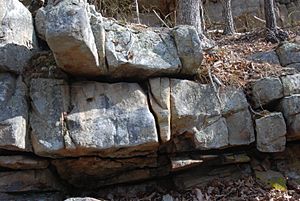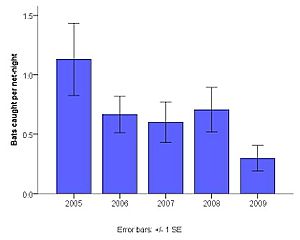Eastern small-footed bat facts for kids
Quick facts for kids Eastern small-footed bat |
|
|---|---|
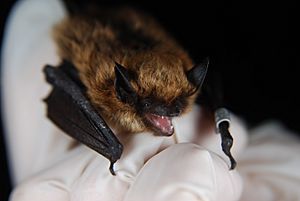 |
|
| Conservation status | |
| Scientific classification | |
| Genus: |
Myotis
|
| Species: |
leibii
|
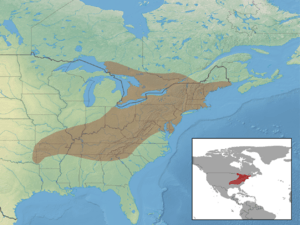 |
|
The eastern small-footed bat (Myotis leibii) is a type of vesper bat. You can find it in southern Ontario and Quebec in Canada. It also lives in the mountains of the eastern United States, from New England down to northern Georgia, and west to northern Arkansas. This bat is one of the smallest bats in eastern North America. It's easy to spot because of its tiny feet and a black "mask" on its face.
For a long time, all small-footed Myotis bats in North America were thought to be the same species. But now, scientists know that the bats living in the western parts are a different species called the western small-footed bat (Myotis ciliolabrum). The eastern small-footed bat is quite rare across its home range. However, you might find many of them in places where their favorite habitat exists.
Scientists think that a disease called white-nose syndrome has caused their numbers to drop. But it's hard to know for sure because these bats hide in places that are difficult for people to find. Many experts believe the species is stable, meaning its numbers haven't changed much recently. But they are still vulnerable because they live in specific areas and need special habitats.
Contents
Meet the Eastern Small-Footed Bat
The eastern small-footed bat is usually between 6.5 and 9.5 centimeters (about 2.5 to 3.7 inches) long. Its wings can spread out from 21 to 25 centimeters (about 8 to 10 inches). It weighs only 4 to 8 grams, which is about the same as two pennies! This bat gets its name from its very small back feet, which are only 7 to 8 millimeters long.
A special feature of this bat is its dark face, which looks like a black "mask." This mask is made by its dark ears and nose. Its ears, wings, and the skin between its legs and tail are usually dark. This makes a strong contrast with the lighter fur on the rest of its body. The fur on its back is dark at the bottom and gets lighter brown at the tips. This gives the bat a shiny, chestnut-brown look.
Like all bats, the eastern small-footed bat has a special skin called a patagium. This skin connects its body to its front limbs and tail, helping it fly. Its head is quite flat and short. It has ears that stand up and are wide at the bottom. It also has a short, flat nose. A small, pointed part called a tragus sticks up from its ear. The bat also has a distinct keel (a ridge) on its calcar, which is a cartilage rod on its back legs that supports the tail membrane.
You can tell this bat apart from other Myotis bats in eastern North America by its forearm length, which is less than 3.4 centimeters. Its tail is 2.5 to 4.5 centimeters long and sticks out past the membrane between its legs. It's most often confused with the little brown bat (Myotis lucifugus). But the eastern small-footed bat's smaller forearm and keeled calcar help tell them apart.
Where Do These Bats Live?
These bats live in northern Arkansas and southern Missouri. Their home range stretches east to the Appalachian Mountains and the Ohio River Basin. It goes south into northern Georgia and north into New England, southern Ontario, and Quebec. They are not found everywhere in these areas; their distribution is "spotty," meaning they are uncommon.
Eastern small-footed bats usually live near rock formations in forests. These can be deciduous forests (trees that lose leaves) or coniferous forests (trees with needles). Most sightings have been in mountains, where exposed rocks are common. However, they have also been seen in rocky areas at lower elevations.
During spring, summer, and autumn, they mostly rest in natural rock outcrops like cliffs and rocky slopes. They also use human-made places like buildings, tunnels, and road-cuts. The largest groups of Myotis leibii have been found in New York, Pennsylvania, West Virginia, and Virginia. Sadly, about 90% of their habitat is on private land, which makes it hard to protect them.
What Do Eastern Small-Footed Bats Eat?
Eastern small-footed bats mainly eat flying insects. These include beetles, moths, and flies. They can fill their stomachs in about an hour after they start eating! They hunt at night, usually in wooded areas. They also forage over streams and ponds, and along cliffs.
Moths make up almost half of their diet. They mostly eat insects with soft bodies. Scientists believe they avoid hard-bodied prey because their skulls are small and delicate. The eating habits of eastern small-footed bats are similar to those of their close relatives, like the California myotis (M. californicus) and the western small-footed bat (M. ciliolabrum). They also eat like other Myotis bats in North America, such as the little brown bat (M. lucifugus) and the northern bat (M. septentrionalis).
How Do They Hibernate?
The eastern small-footed bat is most often found during hibernation. They have been counted in about 125 caves and mines. They are one of the last bat species to start hibernating in the fall and one of the first to wake up in the spring. Their hibernation period lasts from late November to early April.
These bats have been found in colder caves and mines. They can handle lower temperatures than other bat species. Unlike most other bats, they often hibernate in shorter caves and mines (about 150 meters long). They are usually found near the entrance, where temperatures can drop below freezing and the air is dry. These locations might put them at higher risk of white nose syndrome. However, this species seems to have been less affected by the disease than some other bats.
Estimates from winter surveys suggest that white-nose syndrome caused a 12% drop in their population between 2006 and 2011. This is a smaller decrease compared to other Myotis species in the same areas. Other things about their lives make them hard to count but also protect them from the disease. For example, they tend to hibernate alone or in small groups of fewer than 50 bats. They often hide in small cracks. Some bat biologists think these bats might also hibernate outside of caves and mines. Observations of them resting in cracks along sandstone cliffs in winter support this idea.
Spring and Summer Homes
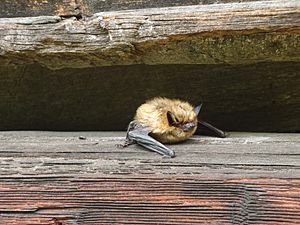
There isn't much information published about where eastern small-footed bats live in spring and summer. The first study on their summer roosting habits was only done in 2011, so information is still limited. This study found that these bats most often use rock roosts on the ground, in rocky fields, and on vertical cliff faces during the summer.
They tend to change their roosts (resting spots) almost every day. Males travel about 41 meters between roosts, and females travel around 67 meters. The study also found that female roosting sites were closer to temporary water sources than male roosts. Females with young need roost sites that get a lot of sunlight. This helps keep their pups warm while the mother is away hunting. Finding summer roosting habitats was once thought to be difficult. However, recent studies show that the species is relatively easy to find if you look near suitable rocky areas.
Reproduction and Life Cycle
Like many other bat species, the eastern small-footed bat usually has only one baby (called a "pup") each year. Very rarely, they might have twins. Because they have only one pup at a time, their populations cannot handle many deaths. This makes them very vulnerable to sudden drops in numbers.
Mating usually happens in the autumn. The female stores the male's sperm throughout her hibernation in the winter. Fertilization happens in the spring when the females become active again. The pregnancy lasts between 50 and 60 days, and the pups are born in late May and early June. Mating has also been seen happening during hibernation if the bats wake up. During breeding season, many bats gather together in a behavior called "swarming." All bats in this group mate with multiple partners. This helps them have more chances to reproduce successfully.
Newborn pups weigh 20-35% of their mother's body weight. They depend completely on their mother. The large size of the young pups means the mother uses a lot of energy. This is why she usually has only one pup a year. Adult males and females might use the same rock areas, but they usually rest separately. In Virginia, both sexes seem to rest alone or sometimes in pairs. However, females start to gather into "maternity colonies" around the time pups are born. They likely stay in these groups until the pups are old enough to be on their own. The size of these maternity colonies isn't well known, but they seem to be smaller than those of other bats in this group.
What Threats Do They Face?
The biggest threat to this species is changes to their habitat, both natural and caused by humans. They are also likely threatened by white-nose syndrome, pollution (especially water pollution), and human disturbance during hibernation. Even small amounts of light, noise, or heat can wake up hibernating bats. When bats wake up, they use up important fat reserves they need to survive the winter. If they are disturbed many times while hibernating, bats (especially young ones) might die. This has been seen in other bat species in eastern North America, like the Indiana bat (Myotis sodalis) and the gray bat (Myotis grisescens).
White-nose syndrome is a fungal infection that attacks bats while they hibernate. In the first six years after it was discovered, about 7 million bats of six different species were estimated to have died from the disease. Early estimates suggested a 12% decline in eastern small-footed bat populations due to white-nose syndrome. However, changes in how many bats were caught in summer surveys in West Virginia and New Hampshire suggested the declines might have been much worse (68-84%) in some areas.
Because these bats rely on exposed rocky areas for their roosting sites, they might be at risk from natural changes like forests growing over their rocky homes. They are also likely threatened by many human activities that affect rocky habitats or nearby areas where they hunt. These activities include mining, quarrying, logging, road building, and other types of development. However, some of these activities might also create new roosting sites by making exposed rock faces.
Protecting the Eastern Small-Footed Bat
The eastern small-footed bat is listed as endangered by the IUCN. Many states in the U.S. where the bat lives have started listing it as threatened. They have begun conservation efforts to help increase its numbers. In Canada, eastern small-footed bats are considered endangered in Ontario and "threatened or vulnerable" in Quebec.
Despite these efforts, not many conservation projects have been started specifically for this species. It's hard to do meaningful conservation because of their unusual hibernation patterns and the lack of information about their spring and summer roosting sites. These bats usually don't use bat boxes like many other bat species. So, building bat boxes isn't a good way to help them with habitat problems. However, they are known to live in human-made rocky habitats like road cuts. This suggests it might be possible to create new roosting sites for them.
How Long Do They Live?
The eastern small-footed bat has been known to live up to 12 years.



